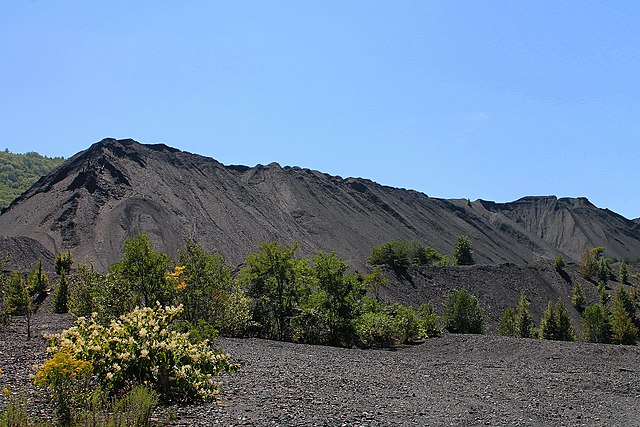Coal refuse (also described as coal waste, rock, slag, coal tailings, waste material, rock bank, culm, boney, or gob[1]) is the material left over from coal mining, usually as tailings piles or spoil tips. For every tonne of hard coal generated by mining, 400 kg (880 lb) of waste material remains, which includes some lost coal that is partially economically recoverable.[2] Coal refuse is distinct from the byproducts of burning coal, such as fly ash.


Piles of coal refuse can have significant negative environmental consequences, including the leaching of iron, manganese, and aluminum residues into waterways and acid mine drainage.[3] The runoff can create both surface and groundwater contamination.[4] The piles also create a fire hazard, with the potential to spontaneously ignite. Because most coal refuse harbors toxic components, it is not easily reclaimed by replanting with plants like beach grasses.[5][6]
Gob has about four times as much toxic mercury and more sulfur than typical coal.[1] Culm is the term for waste anthracite coal.[1]
Disposal
The first step to reclaiming land occupied by coal refuse piles is to remove the refuse matter.[7]
As fuel
Where economically viable, some coal miners try to reprocess these wastes. In more industrialized economies, this may include complex reprocessing,[8] such as fluidized bed combustion in power plants.[5] In less industrialized systems, manual sorting may be employed. For example, in the Jharia coalfield in eastern India, a large cohort of "coal cycle wallahs" manually sort mine tailings with their families, and then transport the salvaged coal on bicycles more than 60 km (37 mi) to market.[9][10]
The burning of waste coal typically produces more environmental toxins than higher energy coals.[1] Modern fluidized bed combustion with limestone for acid gas control can lower toxin emissions to acceptable levels,[lower-alpha 1] concentrating the toxicity into waste ash. For every 100 tons of coal waste burned, 85 tons of waste ash (more toxic versions of fly ash and bottom ash) are created.[5] However, this ash is more stable than the waste and may simply be re-compacted into the mine site with less risk of leaching. It can also be used to neutralize acidic mine discharge.[7]
Other uses
There have been some attempts to use non-flammable coal waste in concrete production, similar to the use of fly ash.[11] The waste ash from burning of coal waste is approved as a source of fly ash by the West Virginia Department of Highways in 2019.[7]
By geography
United States
In the United States, most waste coal piles accumulated from 1900 to 1970 when processing techniques were less sophisticated.[12] The US has a longstanding inspection program of these refuse piles.[13] In Pennsylvania alone, there are over 770 such piles identified.[14] There are at least 18 coal waste burning plants in the United States,[15] mostly in Pennsylvania.
The Grant Town Power Project in West Virginia burns 530,000 tons of coal refuse annually, allowing the reclaimation of 30 acres of land per year.[7] Still, there's criticism regarding the plant's negative profitability and its greenhouse gas emissions from burning coal. The plant has controversially proposed pivoting to cryptocurrency mining for funding.[16] Wider replacement of cement by its fly ash should bring down its carbon footprint.[7]
Etymology
The word in reference to coal waste is of uncertain origin but goes back over 200 years, long before a false etymology as a backronym for "garbage of bituminous"[17] was humorously invented to "explain" it.
Disasters
In the 1966 Aberfan disaster in Wales, a colliery spoil tip collapsed, engulfing a school and killing 116 children and 28 adults. Other accidents involving coal waste include the Martin County coal slurry spill (US, 2000) and the Obed Mountain coal mine spill (Canada, 2013).
References
Wikiwand in your browser!
Seamless Wikipedia browsing. On steroids.
Every time you click a link to Wikipedia, Wiktionary or Wikiquote in your browser's search results, it will show the modern Wikiwand interface.
Wikiwand extension is a five stars, simple, with minimum permission required to keep your browsing private, safe and transparent.
